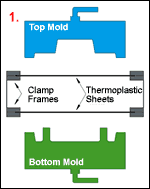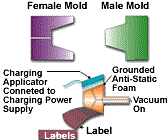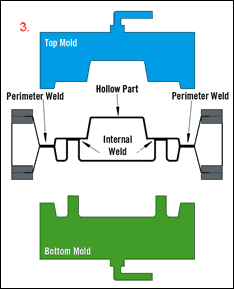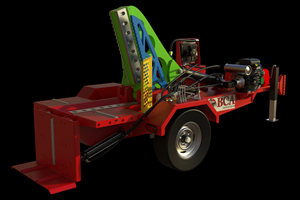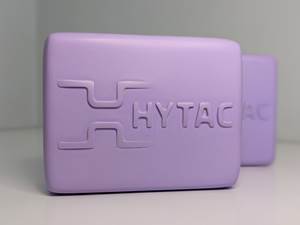Thermoforming Troubleshooter: Avoid Pitfalls in Twin-Sheet Forming
Twin-sheet thermoforming is a promising but challenging process for making hollow or double-walled industrial parts.
Twin-sheet thermoforming is a promising but challenging process for making hollow or double-walled industrial parts. The process is increasingly being adopted to make vending-machine chutes, equipment frames, pallets, bed-liners, air ducts, and both structural chassis parts and surface panels for medical, printing, and electronic equipment.
The most widely used form of twin-sheet forming clamps two sheets horizontally in a rotary or in-line shuttle machine by means of a double clamp frame with spacers. After heating, the upper and lower sheets are simultaneously vacuum drawn into top and bottom female molds. The molds are subsequently brought together, and the hot sheets are compressed at joining areas designed into the mold. The two sheets are thus thermally welded into a single part without use of adhesives or fasteners.
Combining two sheets into a unified part is far more difficult than forming a single sheet. Thermal bonding has to be precise, making proper alignment of tools critical. Control of conditions in the area between joined sheets is also essential, requiring the incorporation of vacuum holes and appropriate cooling devices (e.g., blowing needles) in the mold. And the inability to use plug assist imposes limits on the draw ratio.
Challenge #1: Precise mold alignment
Twin-sheet forming uses two molds that often differ widely in terms of design intricacy and depth of draw (see diagrams). Yet the molds must be perfectly matched in terms of the “press points” where the two sheets are compressed together. The two molds must also align perfectly at the exact moment when platens and molds begin pressing the sheets together—with no “wiggle room” allowed.
Challenge #2: Compensate for compression
Twin-sheet forming involves 40% to 50% compression of the sheets where they are thermally bonded. In one actual case, twin-sheet forming of a pair of 0.125-in. sheets yielded a finished part with only about 0.125-in. thickness in the bonding area. In calculating final wall thickness and mechanical properties of the part, it is necessary to allow for slight variations in compression that can occur.
Challenge #3: Cooling & venting
Twin-sheet processing traps a pocket of heated air between the sheets. Upon cooling, it could collapse the panel. To prevent this, the mold is designed with vent holes that allow cool air inside the panel. Holes should be sized to provide enough cooling and positioned to avoid creating an eyesore.
Hole placement is most critical with appearance parts such as panels for office equipment. One solution is to position holes on the inside face of the panel so they remain invisible to users. When hinges, brackets or other attachments are to be joined to a panel, it is possible to position holes so they are hidden by the attachment. Vent holes can also be designed into the perimeter of parts to disguise their presence.
Vent holes permit a natural flow of cooling air into the panel. But at times it is desirable to positively control cooling. An ideal way is to pump cool air into one side of the hot part and vent it through another hole. That can reduce cycle time and part cost.
Challenge #4: Draw-ratio limits
In single-sheet forming, it is possible to design parts with 3:1 draw ratios and deep undercuts. What often makes this feasible is plug assist, which permits material to be mechanically pushed into the mold to reduce wall thinning. But plug assist is not an option in twin-sheet forming. This means that twin-sheet panels should have generous turning radii at corners and indents and should avoid draw ratios exceeding 2:1.
Draw ratios are computed with the following formula: D = 1 + 2H (L + W) divided by LW, where D is nominal draw ratio and H, L, and W are part height, length, and width respectively. Consider a square box designed to be 10 x 10 in. and 6-in. deep. The draw ratio (2.41:1) exceeds the 2:1 suggested maximum. It would be advisable to redesign the part to reduce D to around 2:1.
Challenge #5: Eliminate shadowing
“Shadowing,” or visible variation in surface finish, often occurs at areas adjacent to where the sheets are pressed together. If the panel is to be painted or is a non-appearance part, consequences are slight. But if unpainted surface finish is important, shadowing becomes a critical issue. One solution is to bead-blast the mold so that the entire panel has a textured finish that masks the shadowing. Another answer is to disguise press points as much as possible (e.g. locate them beneath an attachment).
Challenge #6: Sheet- thickness compatibility
One of the two sheets is often assigned the load-bearing role, the other being intended for cosmetic purposes or to contain insulating foam that will be pumped into the cavity. Yet it is generally best to keep the difference in thickness between top and bottom sheets to 0.0625 in. or less. Greater thickness differentials tend to put twin-sheet forming out of sync: The thinner sheet would be subjected to excessive heating and cooling (because the thicker sheet takes longer), potentially causing excessive sag and warpage.
Kintz Plastics in Howes Cave, N.Y., is a custom heavy-gauge and twin-sheet thermoformer. Michael Righi is engineering manager, and Roger Cusano is a manufacturing engineer. (518) 296-8513, www.kintz.com.
Related Content
Benchtop Spectrophotometer Combines Several, Different Measurement Methods
BYK-Gardner’s new color2view said to open new horizons in color measurement.
Read MorePortable Alligator Shear for Size Reduction of Oversized Plastic Scrap
BCA Industries’ PGS100 hydraulic shear can quickly cut oversized plastic items into smaller pieces for easier shredding.
Read MoreHigh-Temperature Syntactic Foam and High-Slip Plug Materials for Thermoforming
At K 2022, CMT Materials to launch new Hytac syntactic foam and a developmental higher slip plug materials with no PTFE.
Read MoreOMV Technologies Gets New CEO
Kooper brings 33 years of experience in the industrial and consumer packaging industries to OMV--the closed-loop, turnkey, inline extrusion, thermoforming and tooling systems manufacturer.
Read MoreRead Next
Troubleshooting Screw and Barrel Wear in Extrusion
Extruder screws and barrels will wear over time. If you are seeing a reduction in specific rate and higher discharge temperatures, wear is the likely culprit.
Read MoreAdvanced Recycling: Beyond Pyrolysis
Consumer-product brand owners increasingly see advanced chemical recycling as a necessary complement to mechanical recycling if they are to meet ambitious goals for a circular economy in the next decade. Dozens of technology providers are developing new technologies to overcome the limitations of existing pyrolysis methods and to commercialize various alternative approaches to chemical recycling of plastics.
Read More


